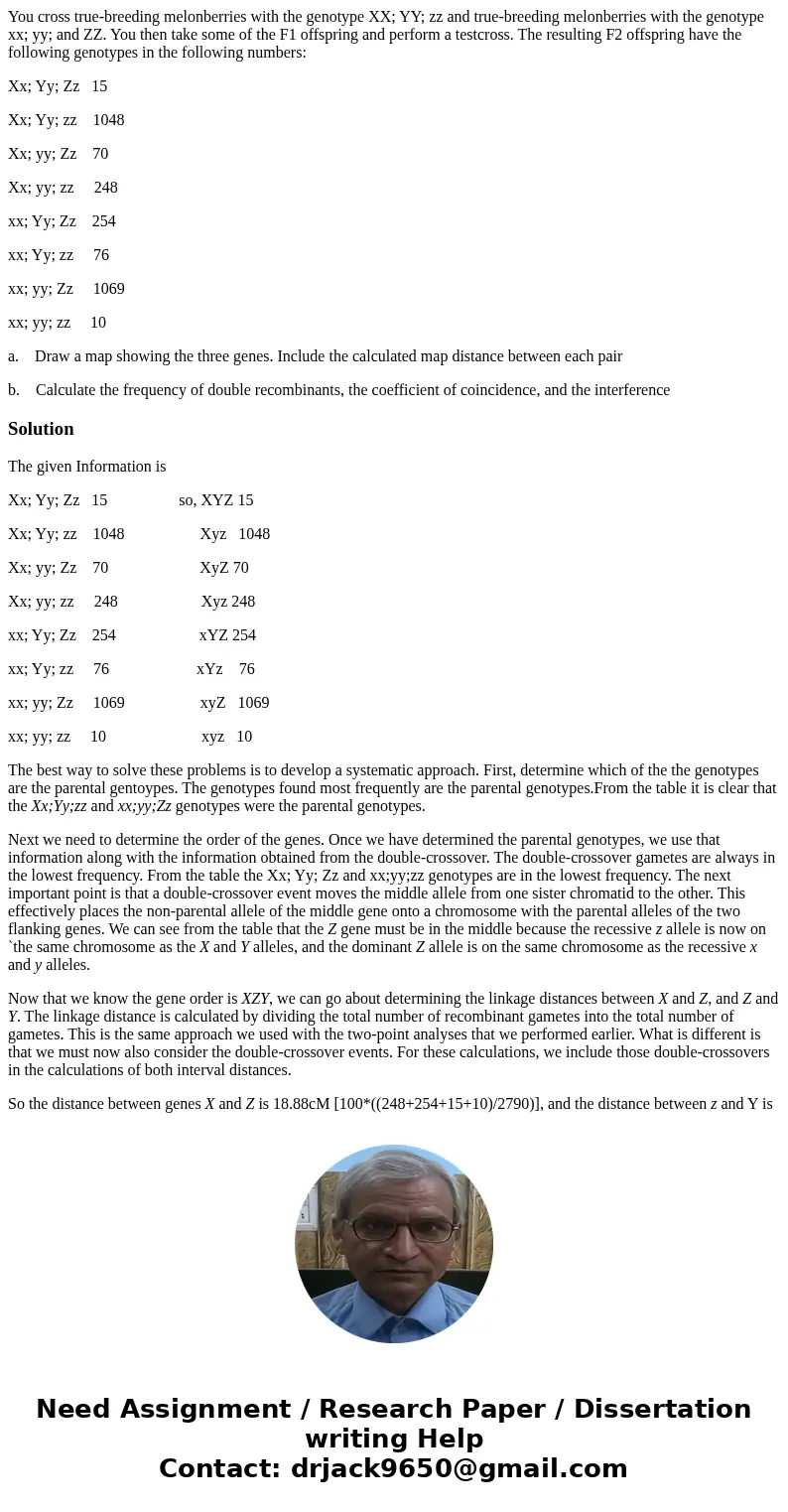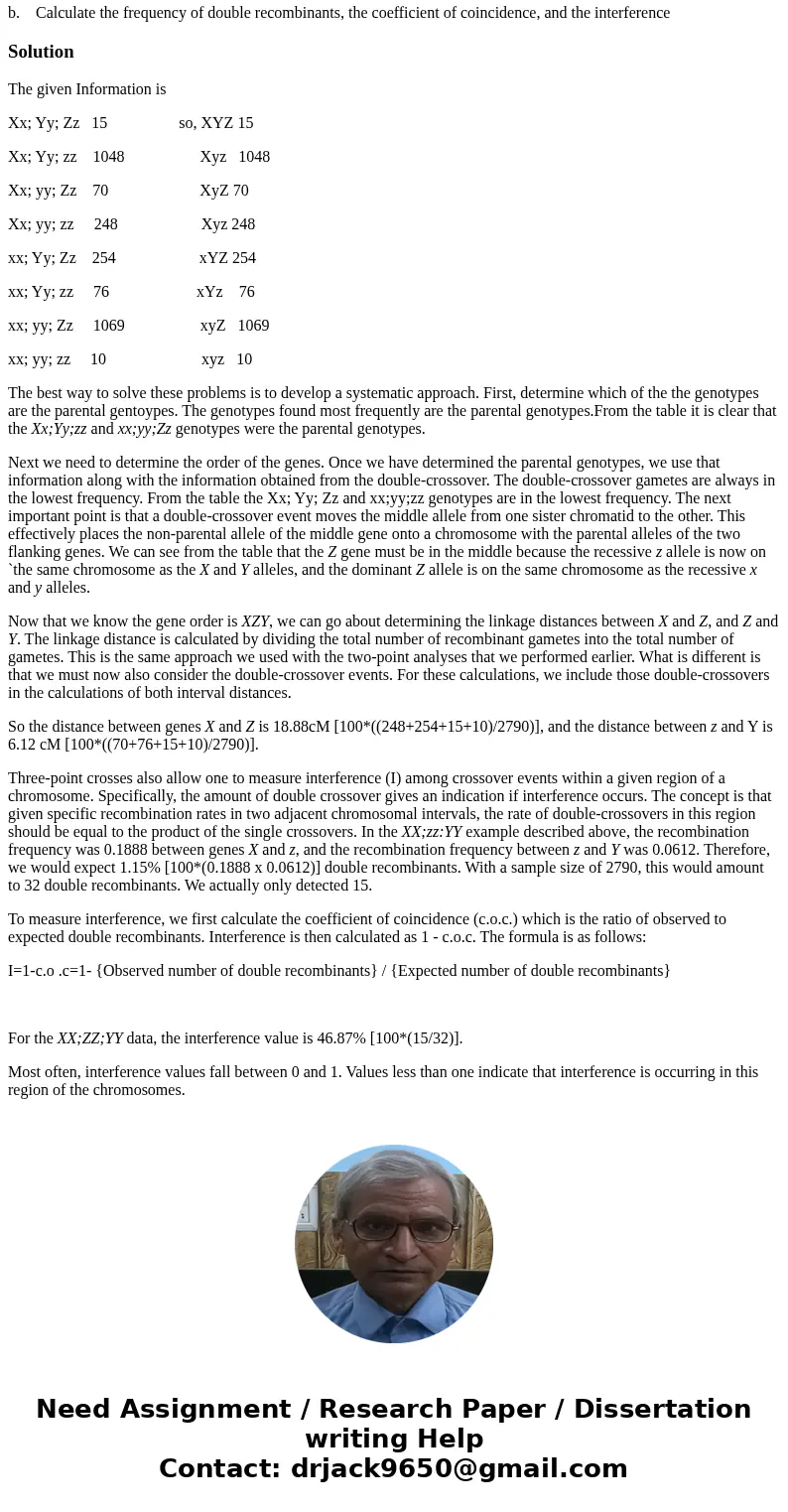You cross truebreeding melonberries with the genotype XX YY
You cross true-breeding melonberries with the genotype XX; YY; zz and true-breeding melonberries with the genotype xx; yy; and ZZ. You then take some of the F1 offspring and perform a testcross. The resulting F2 offspring have the following genotypes in the following numbers:
Xx; Yy; Zz 15
Xx; Yy; zz 1048
Xx; yy; Zz 70
Xx; yy; zz 248
xx; Yy; Zz 254
xx; Yy; zz 76
xx; yy; Zz 1069
xx; yy; zz 10
a. Draw a map showing the three genes. Include the calculated map distance between each pair
b. Calculate the frequency of double recombinants, the coefficient of coincidence, and the interference
Solution
The given Information is
Xx; Yy; Zz 15 so, XYZ 15
Xx; Yy; zz 1048 Xyz 1048
Xx; yy; Zz 70 XyZ 70
Xx; yy; zz 248 Xyz 248
xx; Yy; Zz 254 xYZ 254
xx; Yy; zz 76 xYz 76
xx; yy; Zz 1069 xyZ 1069
xx; yy; zz 10 xyz 10
The best way to solve these problems is to develop a systematic approach. First, determine which of the the genotypes are the parental gentoypes. The genotypes found most frequently are the parental genotypes.From the table it is clear that the Xx;Yy;zz and xx;yy;Zz genotypes were the parental genotypes.
Next we need to determine the order of the genes. Once we have determined the parental genotypes, we use that information along with the information obtained from the double-crossover. The double-crossover gametes are always in the lowest frequency. From the table the Xx; Yy; Zz and xx;yy;zz genotypes are in the lowest frequency. The next important point is that a double-crossover event moves the middle allele from one sister chromatid to the other. This effectively places the non-parental allele of the middle gene onto a chromosome with the parental alleles of the two flanking genes. We can see from the table that the Z gene must be in the middle because the recessive z allele is now on `the same chromosome as the X and Y alleles, and the dominant Z allele is on the same chromosome as the recessive x and y alleles.
Now that we know the gene order is XZY, we can go about determining the linkage distances between X and Z, and Z and Y. The linkage distance is calculated by dividing the total number of recombinant gametes into the total number of gametes. This is the same approach we used with the two-point analyses that we performed earlier. What is different is that we must now also consider the double-crossover events. For these calculations, we include those double-crossovers in the calculations of both interval distances.
So the distance between genes X and Z is 18.88cM [100*((248+254+15+10)/2790)], and the distance between z and Y is 6.12 cM [100*((70+76+15+10)/2790)].
Three-point crosses also allow one to measure interference (I) among crossover events within a given region of a chromosome. Specifically, the amount of double crossover gives an indication if interference occurs. The concept is that given specific recombination rates in two adjacent chromosomal intervals, the rate of double-crossovers in this region should be equal to the product of the single crossovers. In the XX;zz:YY example described above, the recombination frequency was 0.1888 between genes X and z, and the recombination frequency between z and Y was 0.0612. Therefore, we would expect 1.15% [100*(0.1888 x 0.0612)] double recombinants. With a sample size of 2790, this would amount to 32 double recombinants. We actually only detected 15.
To measure interference, we first calculate the coefficient of coincidence (c.o.c.) which is the ratio of observed to expected double recombinants. Interference is then calculated as 1 - c.o.c. The formula is as follows:
I=1-c.o .c=1- {Observed number of double recombinants} / {Expected number of double recombinants}
For the XX;ZZ;YY data, the interference value is 46.87% [100*(15/32)].
Most often, interference values fall between 0 and 1. Values less than one indicate that interference is occurring in this region of the chromosomes.


 Homework Sourse
Homework Sourse